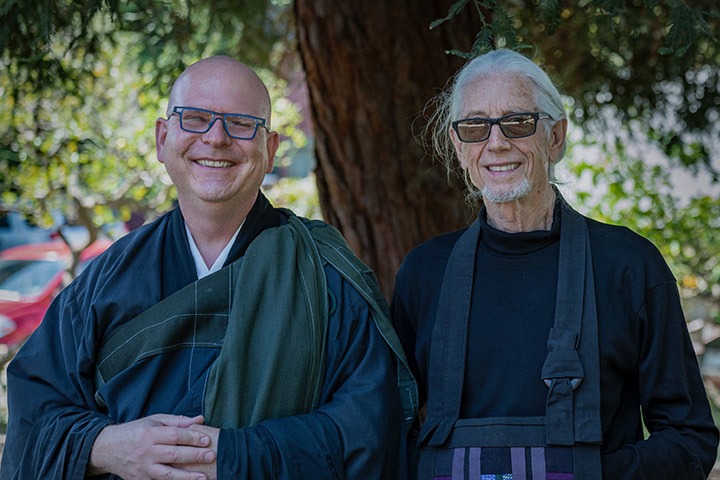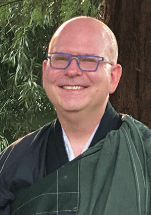
Still Serving in a New Role
July 1, 2022
 by Tom Dharma-Joy Reichert
by Tom Dharma-Joy Reichert
In the April 2022 Installation Ceremony, Sensei Senshin was installed as Head Teacher and I was installed as Head Priest & Preceptor; this completed the actualization of the Three Seats model that Roshi Egyoku had originally envisioned in 2018 and that began when Sensei Faith-Mind was installed as Abbot in May 2019. It has now been a few months since the ceremony—as with so many things these days, it seems both yesterday and a few years ago at the same time—and I appreciate this opportunity to offer some reflections.
The most important thing always to remember is that this is a role of service—service to Zen Center, service to the Sangha, service to all beings everywhere. Of course, the Bodhisattva path is one of service for all of us: the first line of the Four Bodhisattva Vows sets this out clearly: “Numberless beings/I vow to serve them.” Similarly, when we chant the Verse of the Kesa, it declares: “Vast is the robe of liberation/A formless field of benefaction/I wear the Tathagata-teaching/Serving all sentient beings.” The heart of the Mahayana is the ideal of the Bodhisattva—someone who forgoes entering Nirvana until all other beings have awakened. Thus, from the very beginning to the very end, this is a path of service. But as we take on different positions, the path and means of service is always changing. So as a new practitioner, what does service to numberless beings look like? As a novice priest, what does it look like? As a transmitted priest? A transmitted teacher? The call to service remains the same, but how the response manifests will change
From my experience, not only has the means of serving changed as I have taken on various positions, but the fact that these positions are nothing but positions of service has become much more evident. Now, in taking the seat of Head Priest and Preceptor, that the role is one of service is exceedingly clear—and, frankly, quite intimidating. For each of the Three Seats, these are roles of service. And I hope all of you will help to keep me clear about this! While I am certainly not an expert on these things (and I hope never to be!), my impression is that most of the problems that have arisen in practice communities stem from moments when the people “in power” forget that they are in those positions to serve others, and not to benefit themselves.
 This is not a position intended to reinforce the small-self ego. Not at all! In a recent talk, Roshi Egyoku spoke of her experience at a Zen Peacemaker Bearing Witness Retreat among the Lakota Indigenous people, and how, after someone was explaining the Three Tenets, one of the Lakota elders said that, to him, he would translate our practice of Not-Knowing as being humble. Being humble—practicing Not-Knowing—is an important ingredient in holding this seat.
This is not a position intended to reinforce the small-self ego. Not at all! In a recent talk, Roshi Egyoku spoke of her experience at a Zen Peacemaker Bearing Witness Retreat among the Lakota Indigenous people, and how, after someone was explaining the Three Tenets, one of the Lakota elders said that, to him, he would translate our practice of Not-Knowing as being humble. Being humble—practicing Not-Knowing—is an important ingredient in holding this seat.
In his Tenzo Kyokun, Dogen Zenji talks about how the Tenzo, or head cook, should conduct himself/herself/them-selves in preparing the meal for the Sangha. Quoting a prior teacher, he says: “Use the property and possessions of the community as carefully as if they were your own eyes.” This type of care applies not only to the property and possessions of the community, but also to how I, as Head Priest (and all the Seats) should conduct ourselves with the Sangha. The Sangha Treasure is, indeed, a treasure. I hope I always remember this, and I hope that, if I do not, you will help to remind me! (For a funny koan along these lines, see The Hidden Lamp, “The Old Woman Recognizes Mazu.”)
As part of the Installation Ceremony, there were two pledges, one public and the second private. In the public pledge, in a call and response with Roshi Egyoku, I declared the following:
“I, Dharma-Joy, take the Seat of Head Priest and Preceptor. I pledge to serve the Buddha, Dharma, and Sangha with a heart as vast as the world, with gentleness and patience, and with the clear insight of prajna paramita. I take full responsibility for my action and reaction, for my motives and their effects. I pledge not to make excuses for my own unskillful behavior; I pledge not to be self-serving or to seek gain or reputation. I ask for the support of each of you, and of the Sangha, in helping me to fulfill this pledge to you.”
There are many parts to this pledge, and every time I come back to it, various elements resonate differently — just as, when we recite the precepts in a Ceremony of Atonement or a Day of Reflection, different ones stand out for me each time, depending on what is going on in my life. Fundamentally, however, being humble is at the core of this pledge, and it is important for me to be reminded of it regularly.
“For each of the Three Seats, these are roles of service.”
While the First Tenet is Not-Knowing—being humble—the Second Tenet is Bearing Witness. The Lakota elder translated this as “we are all related.” This is equally important to my functioning as Head Priest: recognizing that we are all related, and that I am not separate from all that is. The minute I act from a place that is not humble, the action is coming from a place of “I”—and the minute there is an “I” that I am working on behalf of, there is a “you” that I am not working on behalf of. The I/you gap yawns open, and separation arises. To quote an old robot: “Danger, Will Robinson, danger!”
Of course, this gap is constantly opening, and our practice is to keep closing the gap, over and over and over. In Appreciate Your Life, Maezumi Roshi talks at length about Dogen Zenji’s statement in the Genjokoan, “to study the Buddha Way is to study the self.” He emphasizes that this word “study” has a different connotation in the original Japanese than the intellectual inquiry that we associate with the word in English. In Japanese, the word that is translated as “study” is narao, and it means to do something over and over and over and over and over—you get the idea. It is not pointing to an intellectual mastery, but rather an experiential mastery. (The British writer Malcolm Gladwell, in his 2008 book Outliers, stated that it requires 10,000 hours of practice to become an expert in anything; while subsequent research has disputed the exact figure, the point remains valid and aligns with the point being made by Dogen Zenji and Maezumi Roshi.) Our practice of closing this gap—that’s narao. We close the gap, and we close the gap again, and we close the gap again. That’s why we call it “practice.”
As we know, Zen is an experiential practice, not an intellectual one. We—and I include myself—often come here with an intellectual curiosity, often having read one or more books that aroused what we thought of as an intellectual interest—often because we are so disconnected from our wisdom-hearts and connected only to our thought-minds that we cannot recognize a deep yearning that has been awakened within us.
Ultimately, it doesn’t matter. It gets us in the door, and then we begin to find out that this intellectual mind is, really, no good at all for what this practice involves. Instead, we begin to watch others, to learn from them, and to watch ourselves. This practice is experiential—and experimental. And we are the test subjects! It invites us to be curious, and to observe rather than to judge. And, it then invites us to close the gap, over and over and over. Narao!
One part of serving in these positions is to be willing to sit down in the midst of a furnace. Both I and others hold so many ideas and expectations, internal and external, about what it “means” to be Head Priest, how I “should” behave, how I’m doing it “wrong,” and on and on. As I’ve already experienced, transference and counter-transference are very real! And in inhabiting this seat—this seat of service to the Sangha—my function is to roll all of it into my practice, to help others roll it into their practice, and to do my best to serve others. In doing this, it hopefully helps everyone—me and others both—to surface the assumptions and ideas we may each have about what a “Head Priest” is, and to see where these ideas are creating stuck-ness.
“This practice is experiential—and experimental.”
The Bodhisattva’s function is to affirm life. Sometimes we don’t see that the ideas we have are dead, that we are not affirming life but rather impeding life. The process of recognizing this can be painful. We like our ideas; I like my ideas. Giving them up as “dead words” leaves me vulnerable—there’s “no place on earth where I can hide,” as the Shuso says in the Hossen ceremony. I expect it is the same for you. So, we come back to the same place: practice practice practice! One of the true benefits of long practice is the realization that we can let go of our ideas, our cherished sacred stories—and we will be fine! We are not going to simply pop! out of existence if we loosen our grip on our fixed ideas of who we are and how the world works or should work.
The Third Tenet involves action. We have articulated this a variety of ways over time, and each one has seemed to not quite capture it: we have called it loving action, appropriate action, healing action. Right now we say we take action that arises from Not-Knowing and Bearing Witness. For me, this captures the direction, but maybe not the heart. But taking the Lakota understanding changes it profoundly: I will take action that comes from a place of being humble, and realizing that we are all related. Action that arises from this place—that my wisdom-heart can connect with.
As part of the Installation, as the Head Priest and Preceptor, I offered a silent pledge of my own before the Buddha Hall altar. Hopefully it reflects this Third Tenet of Action:
Putting down my bowing mat, I offer it as a refuge to the whole universe;
Bowing down, I raise all beings above my head. May this Buddha Hall, and may I, always be a refuge and a support.
Dharma Holder Dharma-Joy is the new Head Priest and Preceptor.
